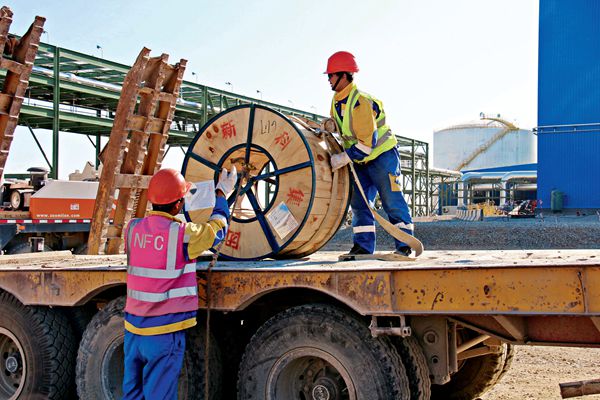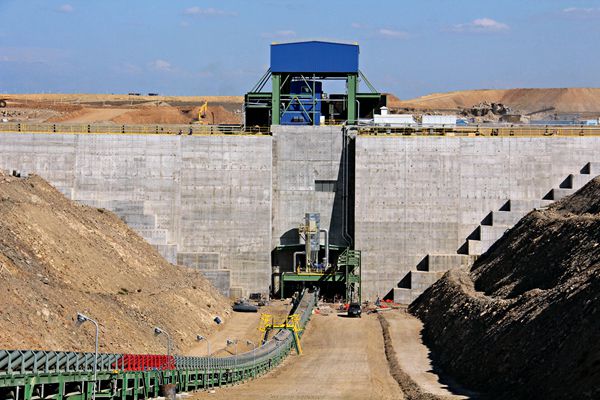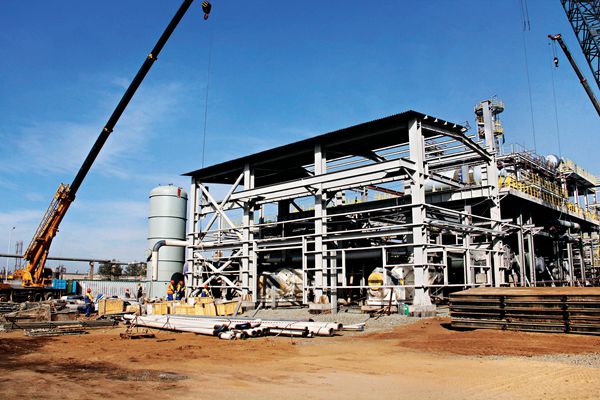By XIE YAHONG
EACH year, countless trains roar through Aktogay in eastern Kazakhstan, the main railway hub of the New Eurasian Continental Bridge. The town has seen additional revitalization due to its subterranean treasure, which lies beneath the grasslands 30 km beyond the downtown area, in the form of a world-class copper mine with reserves of 1.85 billion tons. With China’s help, a dressing plant is under construction that will unveil its precious deposits.
New Techniques, New Industry
Kazakhstan is the world’s largest landlocked state and its vast lands possess abundant resources with huge potential. Historically, events have conspired to prevent the development of its industrial base, which means that deep processing of natural resources is not feasible, leading to a loss in added value. Consequently the government is focusing on industrialization as a means to achieve the country’s development goals.
Chinese President Xi Jinping proposed the construction of the Silk Road Economic Belt during his visit to Kazakhstan in September 2013, and received a positive response. The leaders of the two countries reached a consensus on the alignment of their respective national development strategies, and indicated that they have already begun to see the benefits of their cooperation on the Silk Road Economic Belt. Many Chinese enterprises are now flourishing in various regions of Kazakhstan.
At the end of 2014, local Kazak businesses made the prudent choice of signing a contract worth US $530 million with China Non-ferrous Metal Industry’s Foreign Engineering and Construction Co., Ltd. (NFC) to build a copper ore dressing plant. The Chinese side overcame a number of difficulties, such as tight construction deadlines, a harsh environment, and complex customs clearance formalities for the necessary equipment. However, the installation of all equipment is now complete, and the factory will commence full production this month.

Chinese and Kazakhstan workers work together in the dressing plant.
Upon entering the project site, a 3-km-long ore conveyor belt, towering workshops, and huge heaps of minerals meet the eye. According to Wei Yuguang, general manager of the mine’s general affairs department, the project involved pouring 113,000 cubic meters of concrete, hoisting 17,000 tons of steelwork, and laying 512,000 meters of cable – a scale of construction currently unmatched by any other Chinese overseas enterprise. Meanwhile, Kazakhstan’s insistence on Western standards of project supervision presented a new challenge to Chinese enterprises. After a short period of adaptation, however, the Chinese side incorporated these standards into their work and managed to achieve “European Standards at Chinese speed.”
The completed project will spur on economic development and bring benefits to local people. Mr. Kesimov is a surveyor from a small town nearby, and many of his fellow-townsmen are also employed on the site. “I have been working here for more than a year and am satisfied with both the salary and the conditions,” he said. “After finishing work each day, I often spend time with my Chinese coworkers and try to learn some Chinese.”
Kesimov is optimistic about prospects for his hometown. Upon construction, the plant will process 30 million tons of ore each year, produce 500,000 tons of copper concentrate, and create 2,000 operational jobs. Most importantly, the project will create a new city of industry and technology, bringing fresh opportunities to local people and nearby areas.

The dressing plant at the copper mine.
Completion of the project is also of great significance to China. According to the mine’s project department manager Chen Zhenghai, China’s annual copper consumption is six million tons, accounting for one third of the world’s aggregate demand. In addition to importing large quantities of copper concentrate from Latin America, Chinese enterprises annually import two million tons of residual waste from which they extract copper, which causes severe environmental pollution.
“The Aktogay copper mine is only a few hundred kilometers from the Chinese border, so it offers incomparable advantages for obtaining quality copper at low cost and convenient transportation. It will provide China’s copper industry with a source of clean imports. The copper mine is therefore a prime example of mutually beneficial cooperation between China and Kazakhstan,” Chen said.
Upgrade and Update through China’s Equipment and Technology
The petrochemical works in Pavlodar, a traditional industrial city in northern Kazakhstan, ranks among the country’s top three. It is currently undergoing modernization to improve the quality of its oil products and at the same time protect the environment. China’s equipment and technology is being widely applied throughout this refurbishment.

The vulcanizing plant at the petrochemical works in Pavlodar.
An innovative component of the project is a Chinese-made 650-ton crawler crane with a 92-meter-long mechanical arm used for vulcanizing the works’ equipment. Enterprises on both sides signed a general engineering contract, worth US $170 million, in July 2016. The work will be finished by the end of 2017.
According to Zhang Jianbin, general manager of the project, more than 95 percent of the project’s 250 pieces of equipment were made in China, and most of the technological processes were also formulated there. “These facilities feature mature technology, simple operation, and a low failure rate. The quality and efficiency of the granulator meets advanced world standards,” Zhang said.
According to deputy project manager Zhang Chengwu, the vulcanization plant comprises four parts which expel waste water and gas exhaust during the petroleum refining process. This ensures that the emission index meets the standards required in developed countries. In addition to protecting the environment, the facility also isolates noxious gases such as hydrogen sulfide and sulfur dioxide and transforms them into sulphur, the annual 60,000 ton output of which will create extra economic benefits.
The project has received high praise from local businesses. “This, our third cooperative project with Chinese enterprises, is going smoothly as regards quality and speed, and their facilities have passed the acid test. Thanks to their efforts, our environment will become much cleaner,” said Mr. Nidashkovski, chief engineer of the petrochemical works.
The future is promising for Chinese enterprises that incorporate quality and efficiency into the process of going global. When the then Prime Minister Karim Massimov visited the project in August 2016, he spoke highly of the role played by Chinese enterprises. “We aim to give priority to Chinese enterprises when choosing partners for upcoming refurbishments,” Nidashkovski said.
There are a number of other similar cooperative construction projects in Kazakhstan. The Chinese Ambassador to Kazakhstan Zhang Hanhui said that the two countries have comprehensively deepened their cooperation. There are now 51 capacity and investment cooperation projects, with a gross investment of US $26.8 billion. Promoted by the leaders of both countries, the Belt and Road Initiative and capacity cooperation will create new opportunities for bilateral relations. China relishes the chance to work with Kazakhstan towards a bright future of friendly relations and cooperation.
XIE YAHONG is a reporter with People’s Daily.